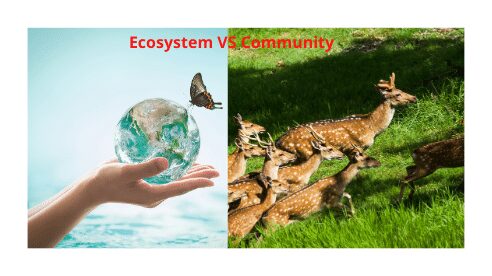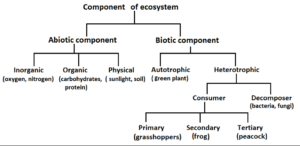
Introduction
The earth is the only place where life exists and every living thing has its own needs and requirements in order to survive on this earth. Organism meets all their needs from the environment thus a relationship develops between the organism and its surroundings this bio-environmental relationship is very complex. The two most common words in this ecology are ecosystem and community. They provide information about the specific habitat of an organism in an ecosystem, their relationship to various inorganic elements in the environment, etc. In ecology, an organism is considered a functional unit. The ecosystem and community play an important role in this functional unit of ecology. Although the role of the ecosystem and community of organisms is essential in describing the interaction of abiotic and biotic elements in the environment, they differ from each other. The ecosystem vs community is described below (1) & (4).
Ecosystem
Definition
An ecosystem is a close relationship between the various organisms in a particular place and their surrounding physical and chemical environment. In which the organisms interact with themselves and the environment through energy flow and nutrient cycles. The main functional unit of ecology is the ecosystem. In 1935, A. G. Tansley first used the term ecosystem (2).
According to Lindeman (1942), “Ecosystems are interdependent, dynamic biological and chemical states”.
Example
Examples of the two major ecosystems of the world are the terrestrial ecosystem and the aquatic ecosystem. Forest ecosystems, grassland ecosystems, desert ecosystems, etc. are terrestrial ecosystems. Pond ecosystem, ocean ecosystem, lake Ecosystem, river ecosystem, etc. are aquatic ecosystems (2).
Characteristics
- An ecosystem is made up of all kinds of abiotic and biotic elements of an environment.
- In an ecosystem, the interactions between different abiotic and biotic components proceed in a very complex way.
- An ecosystem has a specific area or space or field that is small, medium, or large in size.
- An ecosystem develops at a given time therefore considered a unit of time.
- The ecosystem is a system that constantly exchanges energy and matter with the environment. So the ecosystem is called an open system.
- The cycle of nutrition revolves around the ecosystem.
- The ecosystem maintains a comparative balance between different elements that are subject to numerous controls and limitations.
- The sun is the main source of energy for the ecosystem. At different stages of the ecosystem, this energy is converted into thermal energy, mechanical energy, chemical energy, etc.
- Although the whole ecosystem is quite complex, it is a well-organized system with a specific structure.
- The flow of energy through the ecosystem is continuous so the interrelationships between the different elements develop (2) & (5).
Components of ecosystem
The components of the ecosystem are mainly divided into two parts.

Community
Definition
All groups of plants and animals that are related to each other in a particular habitat are called community. That is, plants and animals living in the same environment that adapt to the environment maintain a distinct existence, and interact with other groups are called community. A community is a unit of coordinating species. Although there are millions of species in a community, a relatively small number of species control the power supply in the community. The naming of a community gives rise to the spontaneous birth, growth, and development of each species of plant or animal (1) & (3).
According to Robert H. Grubbs (1978), “community is a collection of plant and population found in one habitat type in one area and integrated to a degree by competition, complementarity, and dependence”.
Example
The tropical rainforests in the region with the largest community in the world. This is because the diversity of flora and fauna of different groups can be noticed here (3).
Characteristics
- Community refers only to the living components of the ecosystem.
- Each community has its own structure, history of development, and use of customs can be observed.
- The diversity of communities varies with the environment.
- The community adapts to the local environment and survives.
- Differences can be observed between different communities of organisms of different shapes.
- The history of the formation and growth of each community is different. For example, the growth of plants in the Congo basin and the history of plant formation and growth in the Sahara desert are not the same.
- Periodic changes can be observed in each community of organisms. For example, large tree clusters in the tropical region, medium tree clusters in the temperate region, and small thorn tree clusters in the Polar region can be observed.
- The complex interrelationships between the biotic and abiotic components of the ecosystem are reflected by the community (1) & (4).
Difference between ecosystem and community
Ecosystem and community are the two important topics in ecology and play an important role in the environment. The ecosystem and community describe the interrelationships of different biotic and abiotic components present in an environment. While both ecosystems and communities play important roles in the environment, they are somewhat different from each other. Ecosystem vs community is described below (4) & (6).
Content |
Ecosystem |
Community |
1. Meaning |
An ecosystem is a natural unit consisting of biotic, abiotic matter, and various organisms where different form a way of life by interacting with each other and their surrounding biotic and abiotic components (2). | Community means all groups of plants and animals that are related to each other in a particular habitat (3). |
2. Consist |
The ecosystem is made up of biotic and abiotic elements. | The community consists only of biotic elements. |
3. Component |
The components of the ecosystem are biotic and (producer, consumer, decomposer) abiotic (sunlight, water, nitrogen, oxygen, protein, fat, etc.) components. | The components of the community are biotic components. |
4. Size |
Ecosystems are large in size. | The community is small in size. |
5. Changeable |
Ecosystems do not change when different elements of the environment change. That is, the ecosystem is Immutable. | When the elements of the environment change, the community is changed. That is, the community is changeable. |
6. Relationship |
Plants, animals, and inert matter are related to each other in the ecosystem.
|
Only plants and animals are related to each other in the community. Inert material has no role in the community. |
7. Role |
The role of green plants is most important in an ecosystem. | The role of both plants and animals is important in the community. |
8. Type of creation |
Ecosystems are created in both natural and man-made ways. | Communities are created by nature. |
9. Collection |
Ecosystems belong to the community. That is, the ecosystem is made up of many communities. | On the other hand, a community is made up of many populations (6). |
Similarities between ecosystem and community
Although there are differences between ecosystems and the community, there are some similarities between them.
- The ecosystem and community both describe the distribution of different species in a particular region.
- Ecosystems and communities both have different eating processes such as herbivores, carnivores, and omnivores.
- Like ecosystems, communities also describe food chains, food webs, energy flow, etc.
- The sun is the main source of energy for both the ecosystem and the community.
- The ecosystem and community contribute to the recycling of various nutrients in the environment.
- Just as the community describes the interaction of living organisms, ecosystems often describe the interaction between living organisms.
- Like ecosystems, food energy flows from the producer level to the highest consumer level (6).
Based on the above discussion, there are different levels in the biosphere. These levels are related to each other. The ecosystem and community are one such layer that plays a significant role in the environment. The biosphere is the combination of ecosystems and communities. The ecosystem and community in the biosphere are interdependent.
